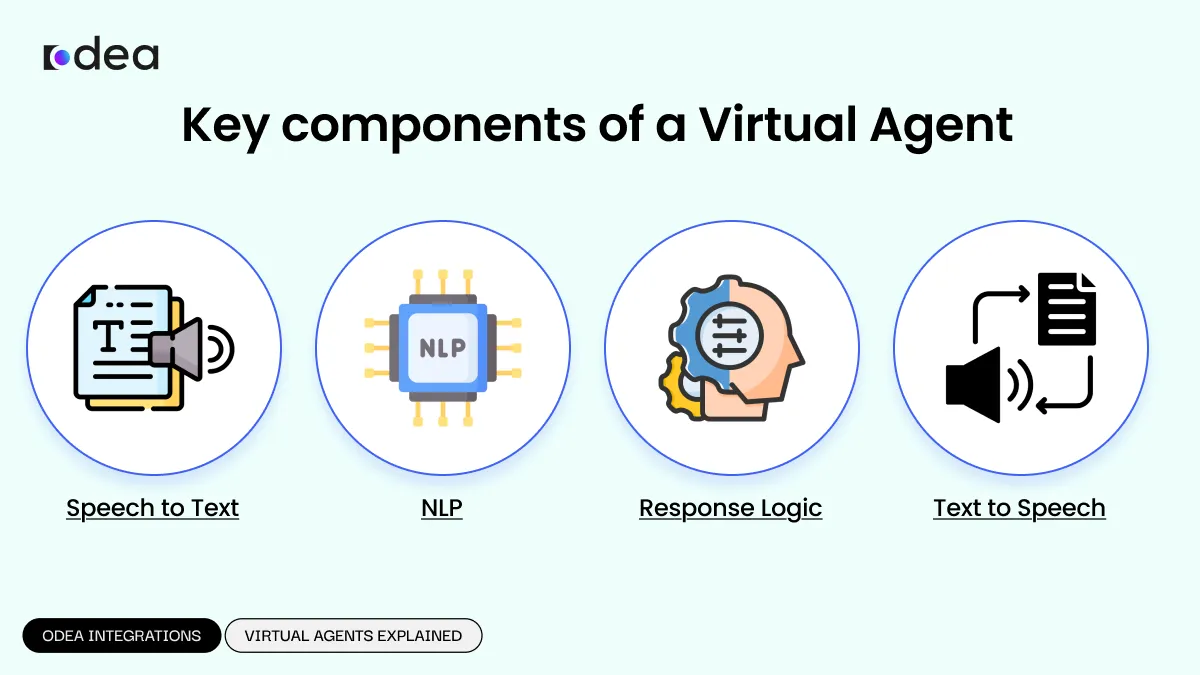Virtual agents aren’t just a glimpse into the future—they’re already reshaping how businesses talk to their customers, day in and day out.
From answering a billing question at midnight to troubleshooting a technical problem in real time, these AI-powered assistants provide immediate and dependable support, all without human involvement. But what exactly happens behind the scenes?
What fuels their ability to understand natural language, deliver precise responses, and keep conversations running smoothly?
In this article, we’ll dive deep into the technology powering today’s virtual agents—covering everything from speech recognition and natural language processing (NLP) to decision-making frameworks and live voice synthesis.
By unpacking each stage of the interaction, we’ll explore how these innovations are changing customer experiences across different industries.
Whether you’re spearheading a digital transformation or developing smarter service workflows, grasping the core mechanics of virtual agents is essential to unlocking their full capabilities.
What Are Virtual Agents?
Virtual agents are smart, AI-driven software designed to carry out conversations that feel natural and human-like across various digital channels. Unlike simple automation scripts, these assistants can understand both voice and text inputs, grasp the user’s intent, and respond accurately and promptly—all in real time. Whether they’re built into mobile apps, websites, messaging platforms, or voice-activated devices, virtual agents ensure a smooth and continuous support experience.
Built to manage everything from straightforward questions to complex service tasks, virtual agents have become a crucial element in customer support strategies across many sectors—ranging from telecommunications and finance to healthcare and retail.
Their strength lies in personalizing conversations, maintaining context over time, and escalating issues, when necessary, which altogether significantly boosts customer experience (CX) and operational productivity.
For more insights on how virtual agents will shape the future of contact centers in 2025, feel free to explore this detailed article,The Future of Customer Service: Virtual Agents.
How They Differ from Chatbots
While many tend to mix up virtual agents with regular chatbots, there are important differences that set them apart:
- Virtual agents connect directly and deeply with backend systems such as CRMs, ERPs, and ticketing platforms to access or update live data instantly.
- They utilize sophisticated Natural Language Processing (NLP) and Machine Learning (ML) techniques to grasp subtle meanings, slang, and even the emotional nuances in conversations.
- These agents handle complex, multi-step dialogues with memory of past interactions, which results in smoother and more natural conversations over time.
- Beyond just text, virtual agents frequently support voice interactions, making them adaptable for use in call centers, mobile applications, and smart home devices.
This advanced intelligence and flexibility make virtual agents a fundamental component of digital transformation efforts — a capability that Odea Integration expertly delivers to clients seeking maximum business impact.
Why Virtual Agents Matter
Virtual agents have rapidly become a vital element in today’s customer service landscape, largely because they deliver AI-driven support with exceptional speed, precision, and nonstop availability.
By automating communication across various digital channels, these tools enable businesses to remain agile and competitive in a nonstop, 24/7 economy.
Here are the key reasons virtual agents are indispensable for enhancing customer experience (CX):
- Always-On Service: Virtual agents operate around the clock, ready to assist even during nights, weekends, and holidays, ensuring seamless support across all time zones.
- Scalability: Whether handling inquiries from a handful or tens of thousands of customers simultaneously, virtual agents scale effortlessly without compromising quality or speed.
- Cost Savings: Automating repetitive questions and routine tasks helps companies reduce labor costs, while still maintaining high standards of customer service—achieving more with fewer resources.
- Uniformity: Each interaction follows a consistent tone, accuracy, and logic, removing the unpredictability sometimes found with human agents.
- CX Enhancement: Providing quick, precise, and context-aware replies improves customer satisfaction, lowers churn rates, and strengthens brand loyalty.
Sectors like e-commerce, healthcare, finance, and telecom rely heavily on virtual agents to handle intricate and high-volume interactions.
Thanks to Odea Integration’s tailored solutions, organizations can tap into the full potential of automation—enhancing operational efficiency while delivering a smooth, human-like customer experience at scale.
For more insights on how virtual agents are shaping the future of contact centers in 2025, you can check out this detailed article here.
Use Cases and Industry Applications of Virtual Agents
Virtual agents are far more than a passing trend—they are reshaping how businesses operate across various sectors by delivering fast, intelligent, AI-driven customer support.
Their capacity to automate complex processes and offer real-time assistance makes them indispensable in industries where efficiency and personalization are critical.
For more insights on how virtual agents are shaping the future of contact centers in 2025, you can check out this dedicated article, AI and Automation in Insurance Contact Centers: Elevating Efficiency and Customer Experience.
Let’s explore how different fields leverage virtual agents to streamline workflows and improve customer experience (CX):
E-Commerce
In the competitive and fast-moving world of online shopping, virtual agents play a crucial role in enhancing customer satisfaction and reducing abandoned carts by:
• Providing real-time order tracking assistance
• Suggesting personalized products based on the customer’s browsing behavior
• Managing returns and refund requests swiftly and autonomously
Healthcare
As patient demands grow in complexity, healthcare providers turn to virtual agents for:
• Scheduling or rescheduling appointments quickly with minimal wait
• Conducting preliminary symptom assessments and guiding patients or escalating when necessary
• Addressing routine insurance and billing inquiries securely and accurately
Finance
In the finance sector, where speed and security are essential, virtual agents support by:
• Offering instant responses to account-related questions
• Monitoring transactions to detect fraud and proactively alerting customers
• Delivering real-time notifications on account activities to boost transparency
Telecommunications
Telecom companies rely on virtual agents to automate at scale by:
• Diagnosing service issues promptly without long call center queues
• Suggesting and processing plan upgrades tailored to customer usage
• Handling billing inquiries such as overcharges or payment reminders efficiently
Thanks to Odea Integration’s cutting-edge virtual agent solutions, businesses can deploy automation that aligns perfectly with their industry’s demands and unique customer journeys—enhancing efficiency, cutting costs, and ensuring consistently excellent interactions.

Key Components of a Virtual Agent
Behind every smooth interaction with a virtual agent lies a sophisticated blend of technologies working together seamlessly. From capturing voice input to delivering precise responses, each step is crucial to enabling AI-powered, real-time customer support.
1- Audio Intake
The process begins when a user speaks into a device such as a smartphone or smart speaker.
The system captures raw audio and then applies noise reduction filters to enhance clarity — a vital step for accurate processing downstream.
2- Speech-to-Text (STT)
Using advanced deep learning models, STT engines convert spoken language into text. These systems are designed to understand diverse accents, slang, and industry-specific jargon.
For example, a virtual agent in banking can recognize terms like “balance transfer” or “APR.”
3- Natural Language Processing (NLP)
NLP acts as the virtual agent’s brain, enabling it to:
- Recognize the user’s intent accurately
- Extract important entities such as names or dates
- Maintain context throughout the conversation to ensure continuity
4- Response Logic
Once the request is interpreted, the system crafts a reply by leveraging:
- Logical decision trees and rules to handle predictable scenarios
- AI-driven decision engines to manage more complex or personalized inquiries
5- Text-to-Speech (TTS)
For voice channels, TTS engines transform text responses into natural-sounding speech. These engines mimic human tone, pace, and inflection to create a conversational experience that feels authentic.
6- Real-Time Execution
Thanks to cloud infrastructure and edge computing, all these steps happen in milliseconds, delivering low-latency responses and scalable performance — even during peak usage periods.
At Odea Integration, we assist organizations in building intelligent virtual agents by integrating these components into cohesive systems designed to grow and adapt alongside business demands.

Common Challenges and Misconceptions About Virtual Agents
Despite their growing popularity, virtual agents are often misunderstood. Let’s address some of the most common myths and clarify the real story behind these AI-powered helpers:
“Virtual Agents Will Replace Human Employees”
This is a widespread misconception. In truth, virtual agents are designed to assist human teams, not replace them.
They excel at handling repetitive and routine tasks quickly and accurately, freeing up human agents to focus on more complex, sensitive, or emotionally nuanced interactions. It’s about collaboration between humans and AI—not substitution.
“They’re Just for Answering FAQs”
Many believe that virtual agents can only handle simple questions. However, modern virtual agents, especially those integrated with backend systems like CRMs and billing platforms, can troubleshoot technical issues, complete transactions, and guide users through multi-step processes across various channels.
Their capabilities go far beyond static, scripted answers.
“They’re Too Expensive and Complicated to Set Up”
While this may have been true in the early days, cloud-based AI platforms, APIs, and ready-made integrations have made deploying virtual agents faster, easier, and more cost-effective than ever.
Companies partnering with Odea Integration often experience a rapid return on investment through lowered support costs, improved customer experience, and scalable service.
By debunking these myths, businesses can better embrace the full power of AI-driven virtual agents and position them strategically within their digital transformation efforts.
How Odea Integration Helps
At Odea Integration, our approach goes beyond simply implementing virtual agents—we make sure they operate intelligently within your enterprise environment.
Our specialty lies in seamlessly linking virtual agent platforms with complex business systems. Whether it’s syncing with Salesforce, integrating legacy ERPs, or facilitating smooth communication with cloud CX platforms, we build solutions that work in harmony with your existing infrastructure.
We know that the true value of a virtual agent comes from its ability to take meaningful action, not just respond passively. That’s why we focus on creating secure, scalable integrations that empower your AI assistant to access live data, execute transactions, and engage in impactful conversations across all your customer touchpoints.
With Odea Integration, your virtual agent becomes more than just smart—it becomes a fully embedded part of your CX strategy, designed to grow with your business and deliver measurable results right from day one.

Conclusion
Virtual agents have moved beyond the realm of futuristic ideas—they are actively transforming how businesses engage customers through intelligent automation and seamless integration.
By combining cutting-edge AI technologies like natural language processing, speech-to-text, and text-to-speech with robust backend system connectivity, virtual agents elevate customer service to unprecedented levels of efficiency and satisfaction.
At Odea Integration, we specialize in connecting virtual agent platforms with your existing enterprise systems effortlessly.
Whether you require integration with Salesforce, legacy ERPs, or cloud CX platforms, our expert team delivers secure, scalable, and efficient solutions that unlock the full potential of your virtual agents.
Don’t let technical challenges slow you down—partner with Odea Integration to unleash the power of AI-driven customer service.
Ready to revolutionize your customer experience with the latest virtual agent technology?
Contact Odea Integration today for a tailored consultation and take the first step toward smarter, faster, and more reliable digital assistance.





